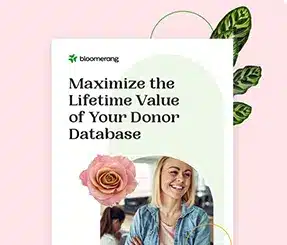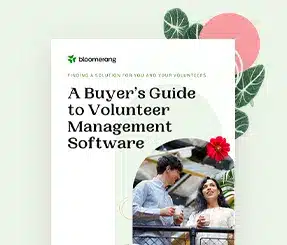7 Simple (but Effective) Ways to Maximize Your Donor Data


Full Platform Overview Chat With Us



Full Platform Overview Chat With Us




Key takeaway: Your nonprofit CRM is among your nonprofit’s most important assets. If you’re not sure that your organization is getting the most value and use out of its donor data, it’s crucial that you take some proactive steps to change that.
By remembering some simple techniques and incorporating them into your data reporting, you can make a major investment in your nonprofit’s ability to make smarter fundraising decisions. Try these seven key ways to maximize the usefulness of your donor data:
Remember, strong data creates stronger financial, marketing, and fundraising strategies!
Use these tips and the linked resources in this article to begin strengthening your CRM and bolstering your organization’s data infrastructure.
Automated data input for any interactions with donors is essential for maintaining a truly useful database.
A comprehensive database of donor information and records, or CRM system, will reveal important propensity trends, enabling your organization to better anticipate giving potential and habits in both existing and future donors. This kind of insight is key to making smarter marketing and fundraising decisions!
Having more data lets you identify more trends, but another main benefit of data input automation is simply the fact that your staff’s time will be freed up to better analyze this data. Rather than manually entering or formatting it for hours at a time, good software will offer a way to fully customize your automatic input settings.
Automatically archiving email records of donor interactions is another smart data move. Not only does this enable you to develop stronger relationships, it also makes it easier to reference your past donor relations and engagement strategies.
The main point: Use online donation tools and email platforms that can automatically populate your database software.
The wealth of digital tools available today make it easier than ever to collect, organize, refine, and use your data in new ways. In addition to automatic input features, CRM integration capabilities are a crucial element to look for in any nonprofit software solution.
Regardless of the exact work your nonprofit does or the types of donors you most often target, there are CRM apps perfectly suited to help you and your data work smarter. With tools integrated directly into your database and management system, you can more easily track and record every important metric from your:
The main point: Always make sure that your fundraising software solutions can integrate with your CRM. This makes them doubly useful as both fundraising and data collection tools.
No matter how much donor data you have or how effective your collection methods are, your CRM can become useless without some overarching guidelines in place!
Set some clear policies for data input. This is the only way to ensure that your CRM is organized, but most importantly, useful. Include clearly labeled sections for any type of information that might be added to an entry.
Setting up a regularly scheduled time once or twice a week to check newer entries and updates for formatting correctness is a great way to stay on top of your donor database upkeep.
Additionally, if your organization is looking to improve its database in the context of a wider capital campaign, a fundraising consultant can help you establish some data guidelines and connect you with essential donor research resources.
The main point: An organized database is a useful database. Set some concrete policies to ensure your data remains tidy as it grows.
Data segmentation is an essential part of maintaining an organized and useful donor database. In fact, one of the main purposes of your donor database should be to make the data segmentation process easier!
Analyzing the data of your existing donors is key to directing meaningful growth. Instead, too many nonprofits make the common data mistake of focusing too heavily on the growth itself, forgetting to look for insights in the data already at hand.
Data segmentation is generally the best way to identify important donation trends, and it’s also a crucial technique for:
The main point: Segmenting your donor information by donor level, giving history, giving potential, preferred communication methods, or any other metric is an extremely important part of using your database to its full potential.
If it doesn’t already do so, your nonprofit should focus heavily on its marketing strategies. This is not only because it’s important to attract new donors, but also because a strong marketing strategy can work wonders for your data collection and upkeep.
Great marketing and up-to-date reporting tools will create a feedback loop of data refinement in a process like this:
The main point: Don’t think of your marketing and donor data analytics as completely separate tasks. Use each to continually support and refine the other!
When collecting data or looking for ways to expand or refine your entries for important donors, be sure to identify some metrics that are extremely useful but often overlooked.
For example, political contribution history is a valuable metric to have for any donor, existing or prospective, since it can serve as a very accurate indicator of commitment and giving potential.
Top prospect research resources should provide you access to this kind of information, but there are plenty of ways to conduct your own research, too. For political contribution history, for instance, you can search official contributions through the FEC, or even find online databases specific to your locale.
Get creative when working on growing your donor database. It’s important to learn as much about your donors and their giving habits, but don’t forget to consider metrics that can more indirectly provide these insights.
The main point: Valuable but often overlooked metrics like employer information can be extremely effective additions to your donor database, especially when it comes to fundraising strategies regarding corporate gift matching. Need more help taking advantage of corporate gift matching revenue? Check out Double the Donation’s matching gift tool, which integrates seamlessly into your favorite fundraising platforms (like Bloomerang!).
Speaking of employer information, one of the easiest ways to unlock more value from your donor database is by running an employer append.
This process generally involves working with a third-party data enrichment service to fill in your donor records with current employment information—like the company they work for, their job title, and whether they qualify for workplace giving programs. While this data might not seem essential at first glance, it can dramatically increase the effectiveness of your fundraising strategies, especially when it comes to corporate engagement. Without this information, you’re likely leaving free money on the table.
The main point: Knowing where your donors work doesn’t just give you a fuller picture of who they are—it opens the door to corporate gift matching, broader workplace giving campaigns, and potential sponsorship opportunities.
If you’re unsure if your organization’s CRM is providing as much value to your work as it can, read through each of these techniques listed above. Which of them has your organization already implemented into its data practices?
Strong donor databases require constant maintenance and cultivation, but the rewards for doing so can be immense!

Comments